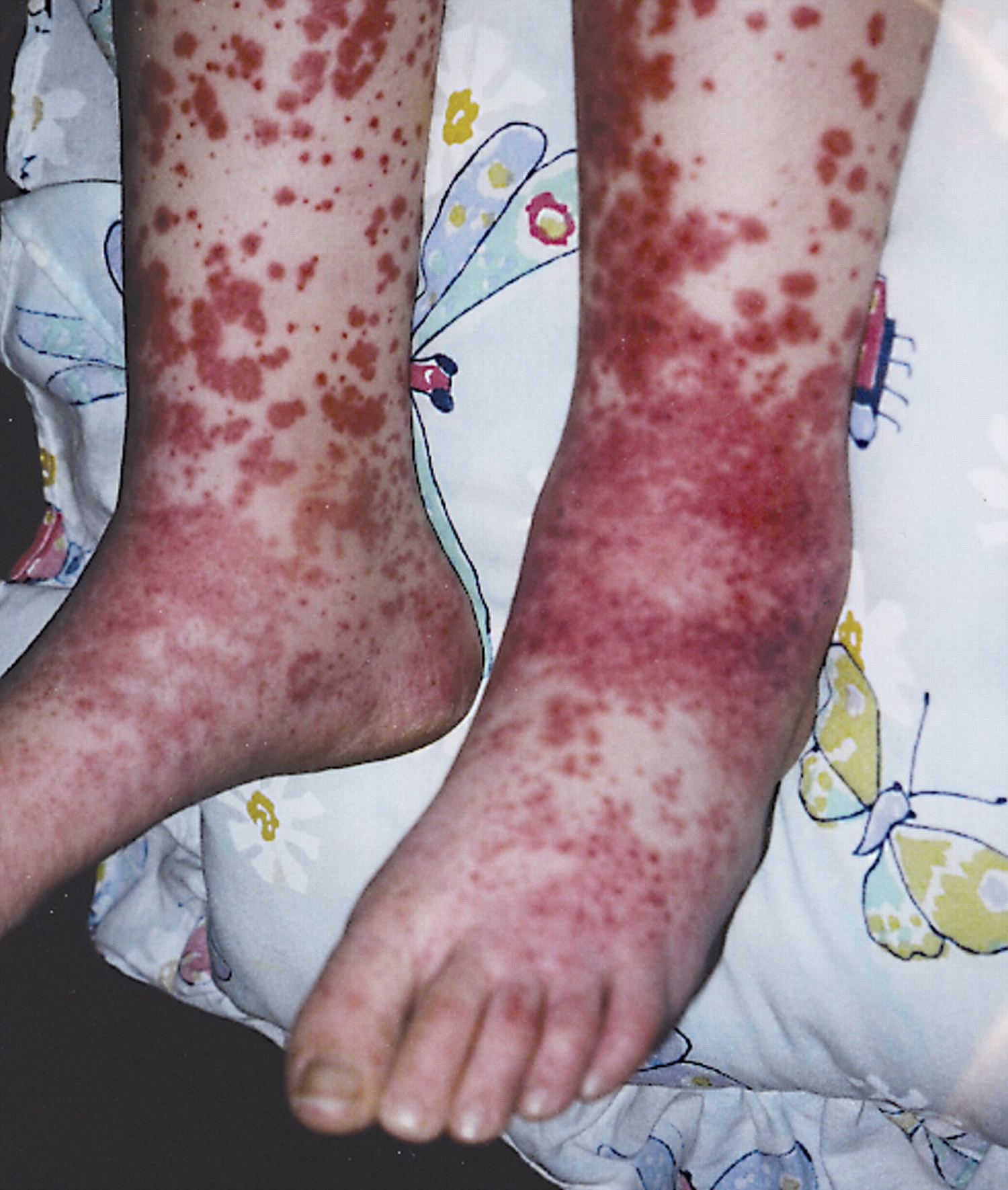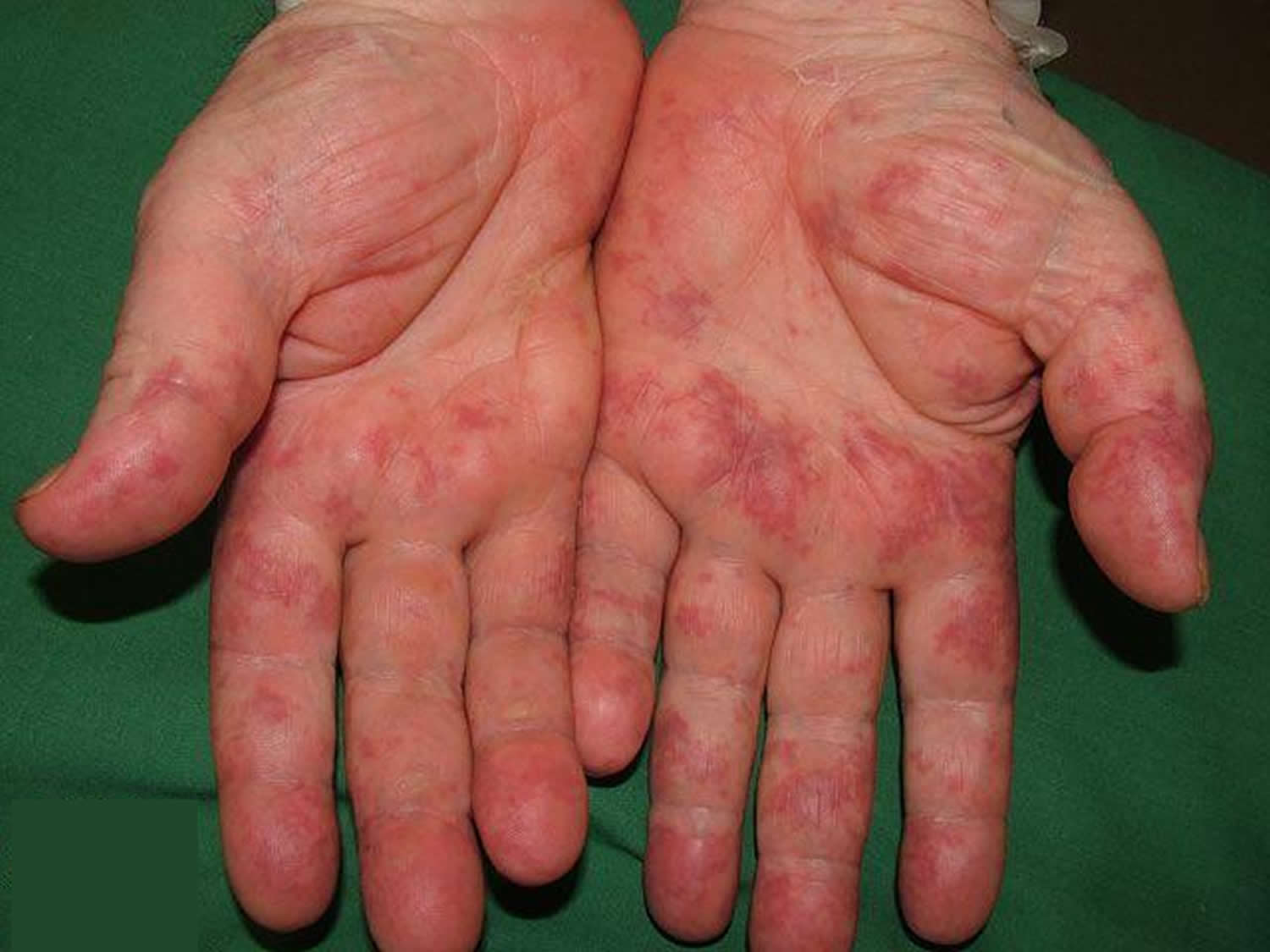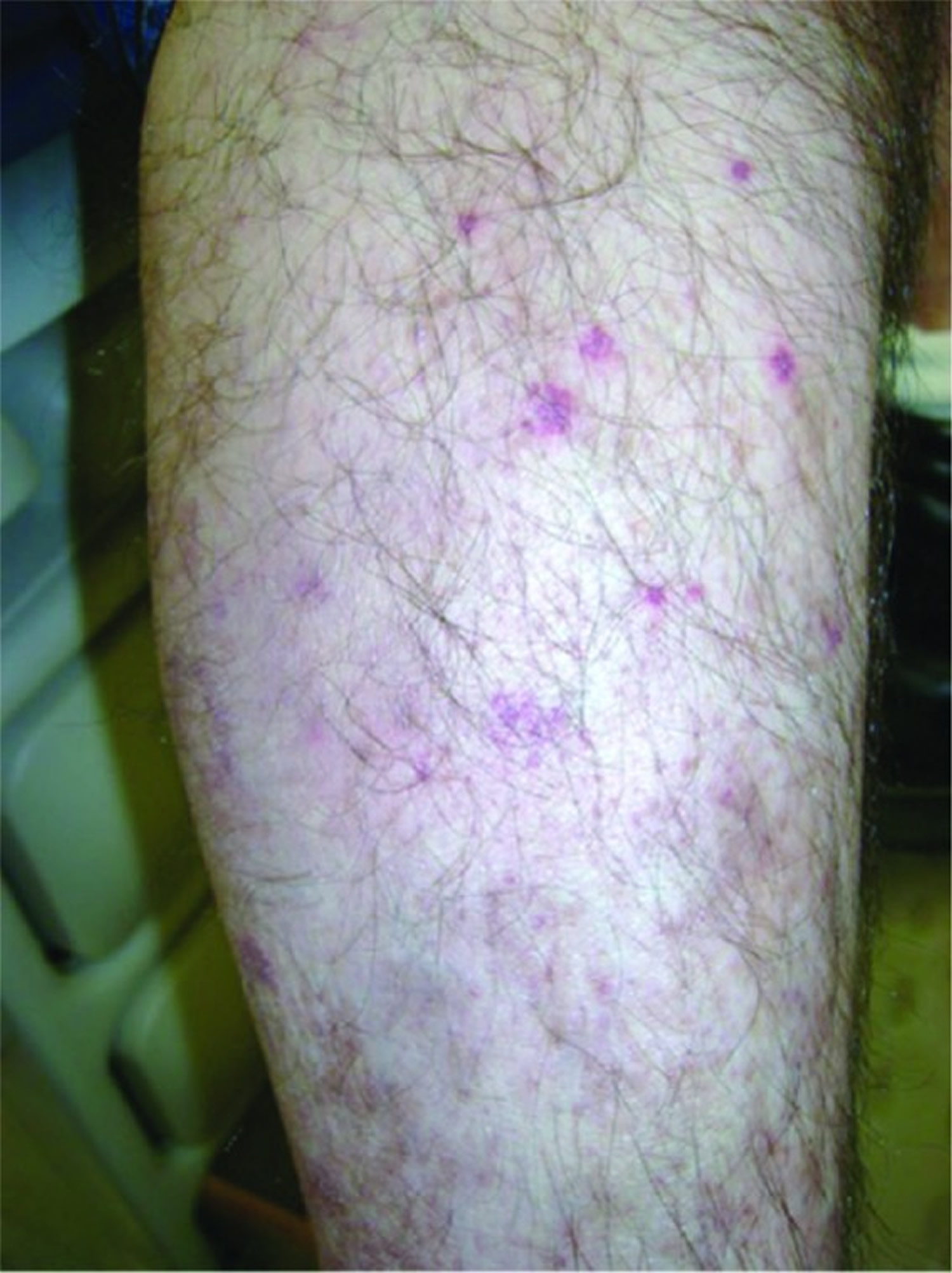Contents
What is cryoglobulinemia
Cryogloblinemia is a vasculitis of small blood vessels that is caused by deposition of cryoglobulins or immune complexes, which are large aggregates of antibodies and the other proteins they are bound to. Cryoglobulins are abnormal immune complexes that thicken and clump together at cold temperatures, usually below 98.6 degrees Fahrenheit or 37 degrees Celsius (the average human body temperature). However, the exact temperature at which this occurs may vary from one person to another. Furthermore why cryoglobulins become solid or gel-like at low temperatures is currently unknown. When these proteins clump together, they can restrict blood flow to joints, muscles, and organs. Eventually, damage or inflammation of affected blood vessels and surrounding tissue can develop, a condition known as vasculitis. Some other types of vasculitis are also caused by immune complexes, but cryoglobulinemia is defined by a laboratory test that identifies immune complexes that fall (precipitate) out of solution in the cold.
Small blood vessels are usually affected, but occasionally larger blood vessels are involved. Common symptoms include skin lesions, joint pain (arthralgia), arthritis, vascular purpura (purple skin marks), livedo (marbling pattern), bleeding conditions and weakness, but specific symptoms can vary greatly from one person to another and can potentially involve multiple organ systems. The severity of cryoglobulinemia is highly variable. Skin, joints, and nerves are commonly affected. Kidney disease is somewhat less common and with a wide range of severity. The heart, brain, or gastrointestinal tract each are affected in fewer than 10% of cases.
Cryoglobulinemia often occurs in association with other diseases, particularly autoimmune or infectious diseases (this is known as secondary cryoglobulinemia). When it occurs without an associated disease it is called idiopathic or essential cryoglobulinemia. Mixed cryoglobulinemia is believed to be an immune-mediated disorder (in which the immune system response to chronic infection causes damage to various tissues) or an autoimmune disorder (in which the immune system mistakenly attacks the body’s own tissue). Many cases of mixed cryoglobulinemia are associated with chronic infection with the hepatitis C virus. In rare cases, no underlying cause for the disorder can be identified (essential mixed cryoglobulinemia).
Cryoglobulinemia tends to develop between 40-60 years of age and affect females more than males by 3:1. Cryoglobulinemia is estimated to affect 1 in 100,000 individuals. Essential mixed cryoglobulinemia occurs in about 1 in 100,000 people.
Most patients with cryoglobulinemia are chronically infected with hepatitis C virus (HCV). However, fewer than 3% of persons infected with hepatitis C virus will develop cryoglobulinemic vasculitis, although the number of patients who test positive for cryoglobulins may be as high as 50%. Many of the remaining patients with cryoglobulinemia have lupus, Sjogren’s syndrome, rheumatoid arthritis, or white blood cell cancers (lymphoma, myeloma, or Waldenstrom’s macroglobulinemia) as the underlying cause. Development of cryoglobulinemia is rare among patients with these diseases. Since all of these diseases can affect persons of both sexes and all ages, cryoglobulinemia affects a similar diversity of patients.
Cryoglobulinemia is usually not deadly. The outcome usually depends on the disease causing cryoglobulinemia as well as each person’s response to treatments. The outcome is not as good when a person’s kidneys are affected.
Can cryoglobulinemia affect the lungs?
Yes. There are three different types of cryoglobulinemia, type 1, 2, and 3. Lung symptoms are common in type 2 and 3 cryoglobulinemia. Type 2 and 3 disease often occurs in people with an autoimmune disease or hepatitis C infection. Lung symptoms may include shortness of breath, cough, or sharp pain when breathing in and out (pleurisy). There have been rare cases occuring with bronchiolitis obliterans organizing pneumonia, vasculitis of the lung, and sudden bleeding in the lung 1. Lung symptoms can be diagnosed using a pulmonary function test.
Can cryoglobulinemia affect the skin?
Yes. Cryoglobulinemia often causes skin symptoms, including redish to purplish flat or slightly raised skin leisons. These leisons most often develop on the lower limbs and feet. Crusty sores and painful ulcers can also occur. Some people have Raynaud phenomenon, livedo reticularis, and painless bluish skin discoloration (particularly of the hands). Skin symptoms worsen with exposure to the cold.
What is the difference between cryoglobulinemia and cold agglutinin disease?
Although there is some overlap of symptoms, cryoglobulinemia and cold agglutinin disease differ in the process by which blood vessels become blocked. In cryoglobulinemia, antibodies accumulate and block blood vessels. In cold agglutinin disease, antibodies (different from those in cryoglobulinemia) attack and kill red blood cells, which then accumulate and block blood vessels 2.
Has any correlation been found between cryoglobulinemia and protein S deficiency?
One study 3 that investigated the contribution of blood clotting disorders (including protein S deficiency) to the symptoms of mixed cryoglobulinemia. In this study, researchers found that having high levels of homocysteine in the blood (hyperhomocysteinemia) was a risk factor for severe purpura and for the presence of skin ulcers. None of the other causes of blood clotting (thrombophilia) that were studied influenced the clinical presentation of mixed cryoglobulinemia.
Cryoglobulinaemia Types
Cryoglobulinemia is classified into 3 major types based on the make-up of the cryoglobulin complex. Each type has been found to be associated with certain diseases.
Cryoglobulinemia is generally broken down in three subtypes. In type I cryoglobulinemia, cryoglobulins are made up of a specific immunoglobulin, usually IgM. Type I cryoglobulinemia is usually associated with an underlying disorder, specifically certain types of cancer. Type II and type III cryoglobulinemia are known as mixed cryoglobulinemia. In these disorders, cryoglobulins are abnormal immune complexes. An immune complex is formed when an antibody attaches to an antigen. Unlike type I cryoglobulinemia, the cryoglobulins in type II and type III contain rheumatoid factor, which is an autoantibody (i.e. an antibody that attacks the body own tissue). The distinction between type II and type III cryoglobulinemia is mostly technical and deals with whether the rheumatoid factor is monoclonal or polyclonal. The clinical pictures of type II and III cryoglobulinemia are similar.
The type of cryoglobulinemia found in patients is roughly 25% with type I, 25% with type II and 50% with type III.
| Cryoglobulin type | Immunoglobulin composition | Associated diseases |
|---|---|---|
| Type I: Single monoclonal antibody | Mainly IgM Less often IgG and IgA | Waldenstrom’s macroglobulinemia Chronic lymphocytic leukemia Multiple myeloma Lymphadenopathy Hairy cell leukemia |
| Type II: Mixed antibody with monoclonal rheumatoid factor (usually IgG or IgM) | IgM-IgG IgG-IgG IgA-IgG | Waldenstrom macroglobulinemia Chronic lympocytic leukemia Multiple myeloma Mixed essential cryoglobulinemia |
| Type III: Mixed antibody with polyclonal rheumatoid factor | IgM-IgG IgG-IgG-IgA | Systemic lupus erythematosus Sjogren syndrome Rheumatoid arthritis Hepatitis A, B or C Systemic sclerosis Vasculitis Glomerulonephritis |
Cryoglobulinemia possible complications
Cryoglobulinemia complications include:
- Bleeding in the digestive tract (rare)
- Heart disease (rare)
- Infections of ulcers
- Kidney failure
- Liver failure
- Skin death
- Death
Most of the time, mixed cryoglobulinemia does not lead to death. Outlook can be poor if the kidneys are affected.
Cryoglobulinemia symptoms
Most patients have weakness or fatigue, and many have sore joints or muscles. The most common appearance of vasculitis in the skin is purpura (bright red circles, from the size of a pinhead up to half an inch, often painful or itchy), but open sores are also common. Damage to nerves (neuropathy) causes numbness, tingling, severe burning pain, and or weakness in a hand or foot. Involvement of the gastrointestinal organs causes abdominal pain. Heart involvement could cause symptoms of a heart attack (chest pain) or congestive heart failure (difficulty breathing, swelling in the legs). Brain involvement can cause strokes, including multiple small strokes, and might also cause headache. Any symptoms that resolve within a few hours are unlikely to be caused by vasculitis. Kidney disease causes no symptoms until severe kidney failure occurs.
Although joint pain (arthralgia) is very common in individuals with cryoglobulinemia, joint inflammation (arthritis) occurs far less frequently. Additional nonspecific symptoms are common including mild to severe itching, mild to severe pain, abdominal pain, muscle weakness, muscle pain (myalgia), and abnormal enlargement of the lymph nodes (lymphadenopathy). In some cases, abnormal enlargement of the liver and/or spleen (hepatosplenomegaly) may occur.
Affected individuals may experience damage to the nerves outside the central nervous system (peripheral neuropathy). Peripheral neuropathy is characterized by numbness or tingling and painful or burning sensations that usually begin in the feet and sometimes the arms. These sensations may worsen at night (nocturnal exacerbation). Peripheral neuropathy may cause muscles weakness in legs and arms.
Affected individuals may also develop an abnormally dry mouth (xerostomia) and abnormally dry eyes (xerophthalmia), a combination which is sometimes referred to as Sicca syndrome. Numbness and tingling and a lack of blood flow to the fingers/or toes when exposed to cold temperatures (Raynaud’s phenomenon) may also occur. Internal bleeding and abnormal blood clot formation has also been reported.
Chronic inflammation of the liver (hepatitis) can occur in affected individuals, particularly those with hepatitis C-associated mixed cryoglobulinemia. Chronic hepatitis is often mild or moderate and may not cause any symptoms. Symptoms that can occur include fatigue and aching muscles or joints. Chronic hepatitis can eventually progress to cause scarring (cirrhosis) of the liver.
Less often, additional symptoms have been reported in individuals with mixed cryoglobulinemia including lung disease, widespread (diffuse) vasculitis, and certain endocrine disorders such as disorders of affecting the thyroid including autoimmune thyroiditis, hypothyroidism and thyroid cancer. Diffuse vasculitis is a severe, potentially life-threatening complication. When the gastrointestinal tract is involved, sudden, severe abdominal pain (acute abdomen) may be the initial symptom.
Diabetes mellitus type 2 occurs with greater frequency in individuals with hepatitis C infection with and without mixed cryoglobulinemia than it does in the general population. Whether individuals with mixed cryoglobulinemia have a higher risk of developing diabetes is not known. Some individuals with mixed cryoglobulinemia may develop cancer as a late complication of the disorder, specifically a type of B-cell lymphoma or a form of liver cancer known as hepatocellular carcinoma.
Common cryoglobulinemia symptoms usually come and go, and may include:
- Skin lesions. Most people with cryoglobulinemia develop purplish skin lesions on their legs. In some cases, leg ulcers also occur.
- Joint pain. Symptoms resembling rheumatoid arthritis are common in cryoglobulinemia.
- Peripheral neuropathy. Cryoglobulinemia can damage the nerves at the tips of your fingers and toes, causing numbness and other problems.
Many organs may be affected by cryoglobulinemia:
- Lungs: Cough, shortness of breath, fluid in the lungs
- Gastrointestinal: Stomach pain, bleeding, enlarged liver and/or spleen
- Kidneys: Hypertension (high blood pressure), glomerulonephritis, nephrotic syndrome
- Nervous system: Visual disturbances, peripheral neuropathy
Table 2. Signs and symptoms of cryoglobulinemia differ between the types as shown in the table below.
| Features of Type I cryoglobulinemia | Features of Type II and III cryoglobulinemia |
|---|---|
|
|
Table 3. Skin problems are almost always present in patients with cryoglobulinemia.
| Skin problem | Type I (%) | Types II and III (%) |
|---|---|---|
| Ischemic necrosis (skin and tissue damage due to lack of blood flow) | 40 | 0-20 |
| Palpable purpura | 15 | 80 |
| Livedoid vasculopathy | 1 | 14 (in type III) |
| Cold-induced urticaria | 15 | 10 (in type III) |
| Scarring of tip of nose, pinnae, fingertips and toes | ||
| Nailfold capillary abnormalities | ||
Figure 1. Cryoglobulinemia rash
Figure 2. Cryoglobulinemia rash legs (purpura)
Figure 3. Patient with Q fever endocarditis and cryoglobulinemia
Cryoglobulinemia diagnosis
Most patients will have a biopsy of skin or nerve that shows vasculitis, or a kidney biopsy that shows a characteristic type of inflammation called membranoproliferative glomerulonephritis. In those settings, a positive blood test for cryoglobulins establishes the diagnosis of cryoglobulinemia.
Cryoglobulinemia blood test: When a blood sample is taken, its temperature is 37 ° Celsius (98.6 °F). It is essential that the sample remains at this temperature until it is placed in a room-temperature centrifuge. Usually, the sample will be stored in a water bath or a container that preserves the sample at body temperature. The sample may be required to be stored for 5-7 days. Eventually, the sample will be spun down in the centrifuge to separate out the cells. If cryoglobulinemia is present, this will cause a white precipitate to form that redissolves upon rewarming.
In patients with syndromes highly suggestive of cryoglobulinemia, the blood test may allow diagnosis without biopsy. The cryoglobulin test is difficult to do properly, since it requires that the tube of blood be transported and processed at body temperature. For this reason, doctors are concerned about the possibility of a “false negative” cryoglobulin test and often order other tests that are usually but not always abnormal in cryoglobulinemia: rheumatoid factor (usually positive), complement (usually with low C4 protein), and serum protein electrophoresis (SPEP, often shows evidence of a “monoclonal” antibody). All patients with cryoglobulinemia should be tested for hepatitis C virus infection.
Tests for cryoglobulinemia include:
- Complete blood count (CBC).
- Complement assay — numbers will be low.
- Cryoglobulin test — may show presence of cryoglobulins. (It is a good idea to check to make sure the lab has experience drawing and storing blood for this test.)
- Liver function tests — may be high if hepatitis C is present.
- Rheumatoid factor — positive in types II and III.
- Skin biopsy — may show inflammation in blood vessels, vasculitis.
- Protein electrophoresis – blood — may show an abnormal antibody protein.
- Urinalysis — may show blood in the urine if the kidneys are affected.
Other tests may include:
- Angiogram
- Chest x-ray
- ESR
- Hepatitis C test
- Nerve conduction tests, if the person has weakness in the arms or legs
Cryoglobulinemia treatment
The main aim of therapy is to find and treat the underlying cause, and limit precipitation of cryoglobulins and the inflammation that results. Patients with cryoglobulinemia should be advised to avoid cold environments to prevent triggering the precipitation of cryoglobulins.
Symptomatic treatment includes:
- Nonsteroidal anti-inflammatory drugs for arthralgia and fatigue.
- Immunosuppressive medications (e.g. corticosteroids, cyclophosphamide, azathioprine) when there is organ involvement such as vasculitis, renal disease, progressive neurological symptoms and severe disabling skin conditions.
- Plasmapheresis is used for severe or life-threatening complications
- Interferon-alfa combined with ribavirin is effective in patients with hepatitis C associated cryoglobulinemia.
- The Anti-CD20 monoclonal antibody rituximab has been reported to be effective in vasculitis due to Type II mixed cryoglobulinemia and hepatitis-C associated cryoglobulinemia.
Identification and treatment of early symptoms such as skin lesions, fatigue or arthralgia, as a result of cryoglobulinemia, will prevent further organ damage and improve patient outcomes.
For patients with hepatitis C virus infection, anti-viral therapy is indicated regardless of the degree of severity. For less severe cases (e.g., purpura, weakness, and joint pain), anti-viral therapy alone is the treatment of choice. Involvement of vital organs requires addition of immune-suppressive drugs. Prednisone, azathioprine, and cyclophosphamide have been widely used, but recent studies have indicated that rituximab may be superior to these medications. Cryoglobulinemia without hepatitis C virus infection is also treated using these medications or methotrexate (which is not used in hepatitis-C infected patients), but no comparison of treatments has been reported. Patients with life-threatening or organ-threatening cryoglobulinemic vasculitis often receive plasmapheresis in addition to immune-suppressive medications.
Type 1 Cryoglobulinemia
This disorder is due to a cancer of the blood or immune system such as multiple myeloma. Treatment is directed against the abnormal cancer cells that produce the cryoglobulin.
Mixed cryoglobulinemia (types 2 and 3)
Mild or moderate forms of cryoglobulinemia can often be treated by taking steps to deal with the underlying cause.
Current direct-acting hepatitis C treatments work for most people who have hepatitis C and mild or moderate disease. As hepatitis C goes away, the cryoglobulins should disappear.
Severe cryoglobulinemia involves vital organs or large areas of skin. It is treated with corticosteroids and other medicines that suppress the immune system.
- Rituximab is an effective drug and has fewer risks than other medicines.
- Cyclophosphamide is used in life-threatening conditions where rituximab is not working or available. This medicine was used often in the past.
- A treatment called plasmaphereis is also used. In this his procedure, blood plasma is taken out of blood circulation and abnormal cryoglobulin antibody proteins are removed. The plasma is replaced by fluid, protein, or donated plasma.
- Peng SL, Schur PH. Overview of cryoglobulins and cryoglobulinemia. In: Basow M. UpToDate.[↩]
- Aljubran SA. Cold Agglutinin Disease. Medscape Reference. http://emedicine.medscape.com/article/135327-overview[↩]
- Casato M, Carlesimo M, Francia A, Timarco C, Antenucci A, Bove M, Martini H, Visentini M, Fiorilli M, Conti L. Influence of inherited and acquired thrombophilic defects on the clinical manifestations of mixed cryoglobulinaemia. Rheumatology (Oxford). November 2008; 47(11):1659-1663. https://academic.oup.com/rheumatology/article/47/11/1659/1789144[↩]







